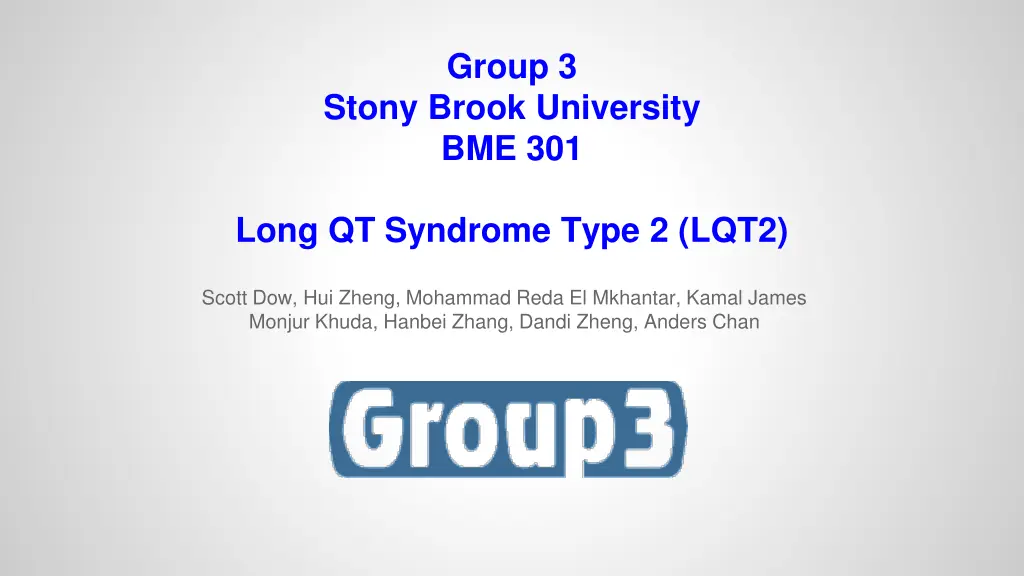
Understanding Long QT Syndrome and LQT2
Learn about Long QT Syndrome (LQTS) and its specific type, LQT2 caused by mutations in the HERG gene. Explore the impact on Ikr channels, cardiac action potential, missense mutations in hERG, and loss in function mechanisms. Gain insights into the risks and complications associated with delayed ventricular repolarization.
Download Presentation

Please find below an Image/Link to download the presentation.
The content on the website is provided AS IS for your information and personal use only. It may not be sold, licensed, or shared on other websites without obtaining consent from the author. If you encounter any issues during the download, it is possible that the publisher has removed the file from their server.
You are allowed to download the files provided on this website for personal or commercial use, subject to the condition that they are used lawfully. All files are the property of their respective owners.
The content on the website is provided AS IS for your information and personal use only. It may not be sold, licensed, or shared on other websites without obtaining consent from the author.
E N D
Presentation Transcript
Group 3 Stony Brook University BME 301 Long QT Syndrome Type 2 (LQT2) Scott Dow, Hui Zheng, Mohammad Reda El Mkhantar, Kamal James Monjur Khuda, Hanbei Zhang, Dandi Zheng, Anders Chan
Long QT Syndrome (LQTS) Comprises a number of disorders, all of which involve an elongated QT interval In this case, caused by delayed ventricular repolarization Not a problem per se, but is a risk factor for more dangerous complications, such as ventricular arrhythmias
LQT2 Syndrome A specific type of LQTS caused by mutations of HERG gene, which codes for Kv11.1, the -subunit that makes up the pores of Ikrchannels
IkrChannels & Kv11.1 Ikris notable for its slow activation/deactivation, and fast inactivation/recovery Kv11.1 is the -subunit of Ikr The Ikrchannel consists of 4 identical - subunits that together form the pore Each -subunit comprises 6 transmembrane helices labeled S1-S6 S4 is most important domain for voltage sensing (+AA every ~3 residues)
Comparing Missense Mutations in hERG Depending on the region affected, mutations can be pathological or benign Most likely harmful mutations are the ones on transmembrane/linker/pore region Mutations may also be nonsense, but these usually never leave the ER *N-terminus, Transmembrane/Linker/Pore, and C- Terminus Domains
Refresher on the Cardiac AP 0. INadepolarizes the cell 1. Itosets the plateau voltage 2. ICa-L& IKsbalance to create a the plateau 3. IKr, IKs, and IK1repolarize 4. Ik1enforces negative Vm Sherwood, L. (2012). Human Physiology, From Cells to Systems (8th [revised] ed.). Cengage Learning. ISBN 9781111577438.
What kinds of loss in function? Reduction in number of channels in the cell membrane (changes effective gkr) Due to reduced protein trafficking since quality control mechanisms prevent departure from ER Decreasing single channel conductance Pore forming domains are mutated Changing probability of channel gates to be open E.g. Deactivation can be accelerated by N or C-terminal mutations (these help regulate gating)
Reduced IkrConductance - So What? Reduction in gkrmeans a reduction in current With a reduction in Ikr, the slope of phase 3 of the AP is drastically reduced If repolarization is too slow (i.e. delayed) EADs are possible!!!
What about Altered Gating? Mutations affecting the function of either one of these gates could affect Ikr in numerous ways, including these that we found in the literature: Recall that Two Things Characterize Ikr: 1. Slow activation and deactivation 2. Fast inactivation and recovery from inactivation Accelerated deactivation Voltage-shifted inactivation Voltage-shifted activation Any of these can also lead to EADs!
Early Afterdepolarizations Any depolarization that happens too early and interrupts another AP phase Can be caused by delayed repolarization as in LQT2 (slope not steep enough) Calcium channels have a limited refractory period - if repolarization is delayed, they can fire again or even create a self-sustaining wave Ventricular tachyarrhythmias!!!
MATLAB Code Manipulations Input parameters Iksplitting and scaling factor in Ikr conductance(g_krscale)
MATLAB Code Manipulations Contd Voltage shift in activation (vshift_a) and scaling factor in deactivation (Bp) Voltage shift in inactivation (vshift_n)
Member contributions Research/Background MATLAB code PPT presentation Website Hui Zheng 1 1 1 0 Scott Dow (presenter) 1 1 1 0 Hanbei Zhang 1 1 0 0 Reda El Mkhantar 1 1 0 1 Kamal James 1 1 0 0 Dandi Zheng 1 0 0 1 Monjur Khuda (presenter) 1 0 1 0 Anders Chan 0 0 0 0 Website: http://you.stonybrook.edu/bmeswagyolo/
References 1. Nakajima, T., et al., Novel mechanism of HERG current suppression in LQT2: shift in voltage dependence of HERG inactivation. Circ Res, 1998. 83(4): p. 415-22. 2. Anderson CL, Delisle BP, Anson BD, Kilby JA, Will ML, Tester DJ, Gong Q, Zhou Z, Ackerman MJ, January CT. Most LQT2 mutations reduce Kv11.1 (hERG) current by a class 2 (trafficking-deficient) mechanism. Circulation. 2006 Jan 24;113(3):365-73. 3. Morita, H., Wu, J., & Zipes, D. P. (2008). The QT syndromes: long and short.The Lancet, 372(9640), 750-763. 4. Chen J, Zou A, Splawski I, Keating MT, Sanguinetti MC. Long QT syndrome-associated mutations in the Per-Arnt- Sim (PAS) domain of HERG potassium channels accelerate channel deactivation.J Biol Chem. 1999 Apr 9;274(15):10113- 8. Kapa, S., Tester, D. J., Salisbury, B. A., Harris-Kerr, C., Pungliya, M. S., Alders, M., Ackerman, M. J. (2009). Genetic Testing for Long QT Syndrome - Distinguishing Pathogenic Mutations from Benign Variants. Circulation,120(18), 1752 1760. doi:10.1161/CIRCULATIONAHA.109.863076 6. Zeng, J., Laurita, K. R., Rosenbaum, D. S., & Rudy, Y. (1995). Two Components of the Delayed Rectifier K+ Current in Ventricular Myocytes of the Guinea Pig Type Theoretical Formulation and Their Role in Repolarization.Circulation Research, 77(1), 140-152. 5. 7. Shimizu W, Moss AJ, Wilde AM, et al. Genotype-Phenotype Aspects of Type 2 Long QT Syndrome. J Am Coll Cardiol. 2009;54(22):2052-2062. doi:10.1016/j.jacc.2009.08.028.






















